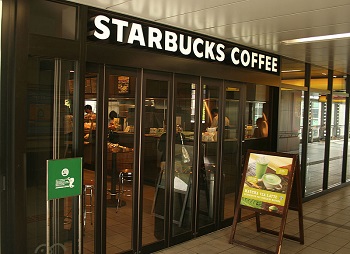Starbucks continues to show strong position in the mobile field
Starbucks is leading the way when it comes to mobile payments. The company has emerged as a sort of unexpected competition for Google, Apple, and others that have invested heavily in mobile commerce. Google was among the most aggressive companies to enter into this market with its Wallet platform. Apple followed suit years late with Apple Pay. Neither of these services have managed to become mainstream successes in the mobile commerce field, but Starbucks’ mobile payment app has.
90% of all mobile payments made in the US in 2013 were done in Starbucks stores
In 2013, 90% of all mobile transactions made in the United States were conducted in Starbucks stores, according to CEO Howard Schultz. Mobile payment volume is also growing by 50% every year, with more than 7 million mobile transactions being conducted at stores every week. Mobile payments now account for 16% of all transactions handled by Starbucks. There have been many questions regarding how Starbucks has managed to find success when competing against large companies like Google and Apple.
Loyalty program provides customers with an incentive to participate in mobile commerce
 One of the ways Starbucks has managed to establish such a strong position in the mobile commerce space has to do with the incentives it gives consumers to use its mobile app. The company has been using incentives to encourage consumers to use its own payment solutions for several years now, and these incentives have become part of the company’s mobile strategy. Starbucks’ loyalty program provides rewards for those that make mobile payments, which has proven quite popular among consumers.
One of the ways Starbucks has managed to establish such a strong position in the mobile commerce space has to do with the incentives it gives consumers to use its mobile app. The company has been using incentives to encourage consumers to use its own payment solutions for several years now, and these incentives have become part of the company’s mobile strategy. Starbucks’ loyalty program provides rewards for those that make mobile payments, which has proven quite popular among consumers.
Convenience is key to finding success in the mobile commerce field
Starbucks also boasts of a prime environment in which mobile payments can thrive. Many of the people that visit Starbucks stores want to take advantage of fast service, and the Starbucks mobile app can help with that. With the app, customers can place orders before they even enter a store, and pay for these orders quickly from their mobile device. By emphasizing convenience, Starbucks has managed to find success where others have failed.
An official from the Federal Bureau of Investigation has cautioned consumers about the “new and highly sophisticated danger.”
A top FBI official has now released a statement to consumers that warns them of the “new and highly sophisticated danger” that is associated with the risks and vulnerabilities in mobile banking.
As a growing number of people look to mobile payments and wallets, the security risks are also rising.
According to the FBI’s Cyber Division assistant director, Joseph Demarest, “Vulnerabilities in mobile banking pose another new and highly sophisticated danger, as mobile banking vulnerabilities may exist on mobile devices that are not patched, and malware can be developed to specifically target the use of mobile devices.” Demarest made this statement as a part of prepared testimony that he presented in a Senate Banking, House, and Urban Affairs hearing on cyber security that was held last week.
There are many different threats to security, but malware is very high on the list in compromising mobile banking apps.
 Demarest specifically pointed out the vulnerability that exists in the malware called Zeus-in-the-middle, which is a mobile version of the malware threatening PCs and laptops called GameOver Zeus. The original was exceptionally sophisticated and was one of the most challenging malware types that “the FBI ever attempted to disrupt,” said Demarest.
Demarest specifically pointed out the vulnerability that exists in the malware called Zeus-in-the-middle, which is a mobile version of the malware threatening PCs and laptops called GameOver Zeus. The original was exceptionally sophisticated and was one of the most challenging malware types that “the FBI ever attempted to disrupt,” said Demarest.
The GameOver Zeus malware was created to swipe the banking credentials that could be used by cyber criminals to be able to either create or redirect wire transfers in order to send the funds to bank accounts located overseas. More than 1 million computers were infected by that malware, worldwide. It led to an estimated loss of more than $100 million.
Although the mobile security threat version of that malware, Zeus-in-the-Middle, has not yet caused the same degree of loss or damage as its PC based counterpart, the fact that it exists at all should be seen as a reflection of the kind of risk that is present and growing in mobile banking and other smartphone and tablet based platforms. These vulnerabilities can make their way into devices by way of infected apps, speak phishing emails, and a number of other pathways.
 One of the ways Starbucks has managed to establish such a strong position in the mobile commerce space has to do with the incentives it gives consumers to use its mobile app. The company has been using incentives to encourage consumers to use its own payment solutions for several years now, and these incentives have become part of the company’s mobile strategy. Starbucks’ loyalty program provides rewards for those that make mobile payments, which has proven quite popular among consumers.
One of the ways Starbucks has managed to establish such a strong position in the mobile commerce space has to do with the incentives it gives consumers to use its mobile app. The company has been using incentives to encourage consumers to use its own payment solutions for several years now, and these incentives have become part of the company’s mobile strategy. Starbucks’ loyalty program provides rewards for those that make mobile payments, which has proven quite popular among consumers.
 Demarest specifically pointed out the vulnerability that exists in the malware called Zeus-in-the-middle, which is a mobile version of the malware threatening PCs and laptops called GameOver Zeus. The original was exceptionally sophisticated and was one of the most challenging malware types that “the FBI ever attempted to disrupt,” said Demarest.
Demarest specifically pointed out the vulnerability that exists in the malware called Zeus-in-the-middle, which is a mobile version of the malware threatening PCs and laptops called GameOver Zeus. The original was exceptionally sophisticated and was one of the most challenging malware types that “the FBI ever attempted to disrupt,” said Demarest.